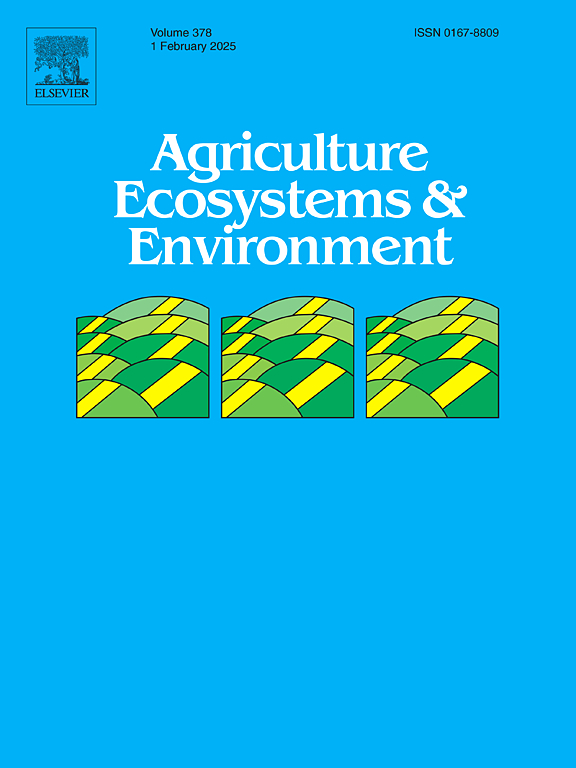黄土高原植被恢复过程中颗粒与矿物相关有机碳发散累积的时空变异特征
IF 6
1区 农林科学
Q1 AGRICULTURE, MULTIDISCIPLINARY
引用次数: 0
摘要
植被恢复是一种很有前景的气候减缓策略,具有增强土壤有机碳(SOC)固存的巨大潜力。然而,关于植被恢复对不同有机碳组分的影响,目前的研究还很少。为了量化黄土高原最典型和最成功的农业土地利用变化——植被恢复对颗粒物(POC)和矿物相关有机碳(MAOC)的影响,我们进行了区域综合。结果表明,植被恢复显著增加了土壤有机碳66 %,高于全球平均水平(45 %),其中POC的增加(103 %)远高于MAOC的增加(48 %),这导致POC在SOC中的比例增加而MAOC的比例降低。此外,还林还林和灌丛还林的POC和MAOC的累积量大于还草还林,人工恢复还林的POC和MAOC的累积量大于自然恢复还林,豆科植物还林的POC和MAOC的累积量大于非豆科植物还林的POC和MAOC。值得注意的是,POC和MAOC的累积表现出不同的时空依赖性。空间上,MAOC的响应显著增加,而POC的响应随纬度变化不显著。随着土层深度的增加,POC和MAOC的响应逐渐减小,但在整个0 ~ 400 cm剖面上始终为正。在时间上,POC和MAOC的反应随修复时间的增加而显著增加,POC的增加比MAOC的增加更明显,并在修复后约2.5年发生。总体而言,我们的研究结果表明,植被恢复后POC相对于MAOC的累积更强,以及它们的时空依赖关系,这强调了SOC多库管理对准确预测恢复生态系统土壤C汇潜力的重要性。本文章由计算机程序翻译,如有差异,请以英文原文为准。
Spatiotemporal variability in divergent accrual of particulate and mineral-associated organic carbon by vegetation restoration on the Loess Plateau
Vegetation restoration is a promising climate mitigation strategy, with considerable potential for enhancing soil organic carbon (SOC) sequestration. However, knowledge on the effects of vegetation restoration on different SOC fractions remains poorly characterized. We conducted a regional synthesis to quantify how vegetation restoration, the most typical and successful agricultural land-use change on the Loess Plateau, affects particulate (POC) and mineral-associated organic carbon (MAOC). We found that vegetation restoration significantly increased SOC by 66 %, higher than the global average estimate (<45 %), with a much greater increase in POC (103 %) than in MAOC (48 %), which resulted in an increased proportion of POC in SOC but decreased that of MAOC. Moreover, the accrual of POC and MAOC was greater for conversion to forest and shrubland than to grassland, and for artificial restoration than for natural restoration, and for legume species than for non-legume species, respectively. Notably, the accrual of POC and MAOC showed divergent spatial and temporal dependencies. Spatially, the response of MAOC increased significantly, whereas that of POC showed no significant change with the latitude. With increasing soil depth, the response of POC and MAOC gradually decreased, but was always positive across the whole 0–400 cm profile. Temporally, the response of POC and MAOC increased significantly with time since restoration, and the increase in POC was more pronounced than that in MAOC and the accrual occurred approximately 2.5 years post-restoration. Collectively, our findings show a stronger accrual of POC relative to MAOC after vegetation restoration, along with their spatial and temporal dependencies, which underscore the importance of multi-pool management of SOC for accurately predicting the soil C sink potential in restored ecosystems.
求助全文
通过发布文献求助,成功后即可免费获取论文全文。
去求助
来源期刊

Agriculture, Ecosystems & Environment
环境科学-环境科学
CiteScore
11.70
自引率
9.10%
发文量
392
审稿时长
26 days
期刊介绍:
Agriculture, Ecosystems and Environment publishes scientific articles dealing with the interface between agroecosystems and the natural environment, specifically how agriculture influences the environment and how changes in that environment impact agroecosystems. Preference is given to papers from experimental and observational research at the field, system or landscape level, from studies that enhance our understanding of processes using data-based biophysical modelling, and papers that bridge scientific disciplines and integrate knowledge. All papers should be placed in an international or wide comparative context.
 求助内容:
求助内容: 应助结果提醒方式:
应助结果提醒方式:


